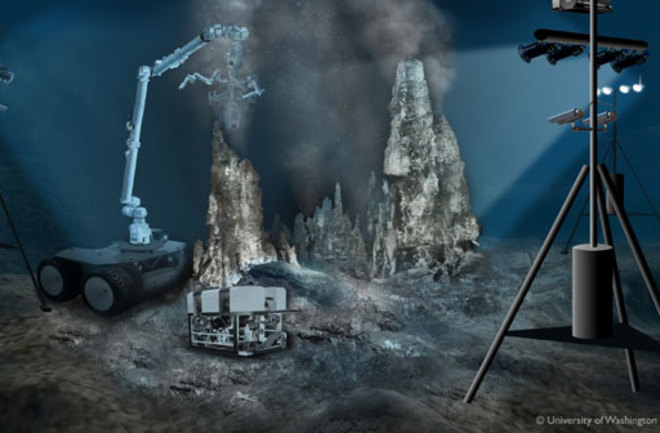John Delaney stepped out onto the deck of the Thomas G. Thompson shortly before dawn one day last August and paused to look at Puget Sound, an evergreen-lined inlet near Seattle that meanders out to the Pacific. As the ship made its way toward the ocean, he glanced at the white peaks of the Olympic Mountains with a knowing eye. “Those rocks were created on the seafloor, distilled from molten material from the mantle,” he said. “They were part of a tectonic plate that got jammed up onto the continent.” He watched as the glassy, protected waters of the sound gave way to ripples and sparkling wavelets, hints of the interplay between wind and sea and the currents that course around the globe. He registered the sun on the water and pondered the patterns of energy fueling the blooms of tiny marine plants that nourish an ever-expanding web of life. Every facet of the ocean conjured another, weaving a tapestry so complex he knew he would be studying it for the rest of his life.
To unravel that intricate tangle of relationships, Delaney has envisioned a web of his own: a sprawling undersea network off the coast of Washington and Oregon whose strands of power lines and fiber-optic cables would stretch hundreds of miles along the seafloor, connecting researchers with the ocean like never before. On this expedition, Delaney was setting out to test key components of the system for the first time. And this deep-sea Internet is just one arm of the enormous $770 million Ocean Observatories Initiative (OOI) now under way.
In addition to Delaney’s cabled network, the program includes five other sites scattered from the tip of South America to the waters near Greenland, where swarms of instruments will shuttle up and down cables and fly through the water on robots controlled from shore. For decades, sensors will gather data on water chemistry, currents, photosynthesis, animal activity, and seafloor eruptions and earthquakes. When the work is complete, researchers will piece together a systemwide view of the marine environments that cover more than two-thirds of the planet, bringing into focus the interrelationships among the seafloor, the water, and the atmosphere. Does ocean chemistry alter climate? Does undersea geology impact fish populations? Will the web of marine life deliver new energy sources from the sea?
“It’s pioneering a way of investigating the ocean,” says Timothy Killeen, assistant director for geosciences at the National Science Foundation (NSF). “It will lead to areas of research that we can’t even imagine today.” For Delaney, that vote of confidence represents both opportunity and pressure. “If this doesn’t succeed,” he says, “the next time ocean scientists want to tackle something big, we won’t get the chance.”
Like so many oversize ambitions, the scheme to build a seafloor Internet took shape in a bar. In 1991 Delaney, an oceanographer at the University of Washington, went out for a drink one evening with Alan Chave, an ocean engineer and marine geophysicist based at the Woods Hole Oceanographic Institution. The two were collaborating on a study of mid-ocean ridges, chains of volcanoes and hydrothermal vents that snake around the planet like the seams on a baseball.

